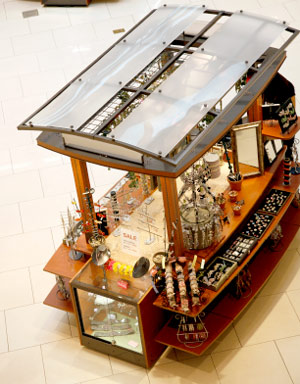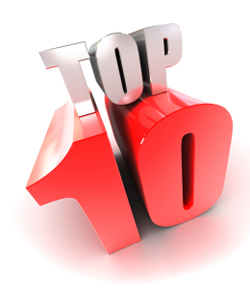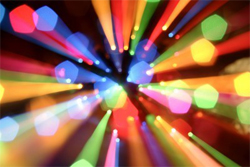Tradeshow Lessons from the Mall
It seems like every time my wife and I go shopping at the mall, I get a reminder of what it takes to make exhibiting at a tradeshow a great investment. I think we have all had the same experience – I’m not talking about the big department stores or even the smaller shops that take up most of the space at the mall. I’m referring to the little carts that sit out in the open.
Most of these tiny stores (or kiosks) are staffed by one young person who spends most of their time talking on their cell phone, texting or chatting with friends who stop by. Just like most companies that exhibit at tradeshows, these small businesses are depending on the visual appeal of their products to attract potential customers. While I have no firsthand knowledge of how profitable these carts are, I think it’s safe to say their owners would be thrilled if they could increase sales by 10 – 20% each day.
 The exception to the rule are the carts that are selling jewelry or eyeglass cleaner. As you walk by, you will almost always be approached by someone who asks, “Excuse me, ma’am, would you allow me to clean your rings?” or “Excuse me, sir, can I clean your eyeglasses for you?.” I would venture to say that the people that work these carts have been given some training and some incentive. Not only that, I’ll bet that they sell much more of their product than the carts staffed by distracted teens.
The exception to the rule are the carts that are selling jewelry or eyeglass cleaner. As you walk by, you will almost always be approached by someone who asks, “Excuse me, ma’am, would you allow me to clean your rings?” or “Excuse me, sir, can I clean your eyeglasses for you?.” I would venture to say that the people that work these carts have been given some training and some incentive. Not only that, I’ll bet that they sell much more of their product than the carts staffed by distracted teens.
My personal favorite is the one demonstrating and selling the foam airplanes that come right back to you when you throw them. Usually, two young people are constantly throwing the planes and they always come right back to them. Just the activity alone makes you stand there and watch, which greatly increases the chances you’ll buy something.
So how does all of this relate to trade shows?
Even though the situations are completely different, there is one common factor. The buyers in each case are human beings. Most human beings respond to similar stimulus. Get the people that work your exhibit to approach prospects with as much energy as the people selling jewelry cleaner. Have some activity in your booth like the people throwing foam airplanes. I’ll bet you’ll see a big improvement in your trade show ROI.
Scheduling Tradeshow Staff
Scheduling and keeping track of booth staffers is a vital bit of information that should not be overlooked during tradeshow preparation. Planning should begin well in advance of the show.
A master schedule binder should be created that includes:
- All planned meetings in the booth, including times and attendees
- A list of booth staffer responsibilities, assigning tasks, and a designated time to perform tasks
- A detailed log of times staffers will be in the booth, on break, or dining.
 This binder will be most useful if it is kept at the main reception counter for any staffer to view. A master log of meetings should indicate who the attendee plans to see, and what will be discussed. If a private or semi-private meeting is in order, a conference room or sit down area should be available for guests and staff. Log these times accordingly, and block out conference rooms for this time slot. Some exhibit managers will even go as far to know the potential dollar amount in revenues each and every planned visitor could mean to the company. This is incredibly valuable information to share with all booth staffers, so when an important guest walks in, they are treated cordially and respectfully.
This binder will be most useful if it is kept at the main reception counter for any staffer to view. A master log of meetings should indicate who the attendee plans to see, and what will be discussed. If a private or semi-private meeting is in order, a conference room or sit down area should be available for guests and staff. Log these times accordingly, and block out conference rooms for this time slot. Some exhibit managers will even go as far to know the potential dollar amount in revenues each and every planned visitor could mean to the company. This is incredibly valuable information to share with all booth staffers, so when an important guest walks in, they are treated cordially and respectfully.
Use your schedule to make responsibilities clear to all staff. If a different group of staff is assigned to setting up, or prepping the booth prior to the show, demand that they be there on time. During the show, indicate who will lock up, power down laptops, and secure valuables at the end of the day. Make sure everyone knows who has locking storage keys, and where they are to be found. Have a crew come in early on days two and three, to power-up, check that everything is working, clean-up, and wipe down any dirty areas. Make sure that the booth is absolutely “show ready” ten minutes prior to the show floor opening.
Have a master phone list available in your binder as well. All staffer phones and emails should be easily available to any and all people in the booth. Include arrival/departure times for each staffer, hotel lodging information, and an emergency contact for each staffer. Be sure to have staffers notify someone if they are running late, or may miss a meeting. Someone else may need to cover for them in the event they cannot make an important meeting, otherwise, an attendee may be put-off and not return. Make sure to include anyone hosting or attending a press conference, and, if it is off location, indicate where and in what rooms. It is critical to know where key people are at all times.
It may sound like a bit of extra work prior to the show, and your schedule can be as simple or complex as you choose, but the time spent is well worth the investment. You will find that adding this level of organization will result in a more organized, responsible, and thoughtful staff, better prepared to meet any challenges on an oftentimes hectic show floor.
Top 10 Tradeshow Display Design Fundamentals
- Study the show’s attendees – know how many are expected and which ones represent prospects for you.
 Know your position in the convention center – the location of your booth as related to the main entrance, the largest exhibits, food and beverage areas or anything else that is likely to impact attendee behavior.
Know your position in the convention center – the location of your booth as related to the main entrance, the largest exhibits, food and beverage areas or anything else that is likely to impact attendee behavior.- Think about both long and short range corporate identification – how will prospects find you, and how will they know who you are when they are standing in front of your booth?
- Consider an activity to attract attention – live demonstrations, presentations or other booth activities will cause people to stop and watch.
- Imagine an important prospect approaching your booth – What will they see? How will they be greeted? How much time will they want to spend with you? How will you record their information for follow up?
- Think about the sales process – your booth graphics can be arranged to assist and guide the sales presentation process.
- Consider the image that you want to project – make a list of adjectives that describe your corporate image.
- Think about the practicalities – presentation stations, storage of briefcases, utilities, meeting areas, video, etc.
- Come up with a budget – Not only a number but also what it should include.
- Look for photos – Find some images that are examples of booths you like. Be sure to indicate what it is you like about each particular photo.
Thinking about and preparing these things before you contact an exhibit designer will make the process much easier and more efficient. Best of all, with the right preparation, you’ll end up with a design that fits your style and meets your needs!
Trade Show Success: Integrate Live Online Video
Trade shows have always been great PR opportunities because they get press coverage. For decades, companies have used trade shows to make major announcements or introduce new products. Usually, these announcements get more press coverage than they would ordinarily get because reporters covering the shows are looking for news.
 For the past few years, companies have been extending their news reach by using social media platforms such as Facebook or Instagram to provide live online video of company announcements, news conferences, trade show product demonstrations and other events directly from the trade show floor. All of these platforms incorporate live chat that can be used for “Q and A” sessions between company representatives and reporters, bloggers or the general public.
For the past few years, companies have been extending their news reach by using social media platforms such as Facebook or Instagram to provide live online video of company announcements, news conferences, trade show product demonstrations and other events directly from the trade show floor. All of these platforms incorporate live chat that can be used for “Q and A” sessions between company representatives and reporters, bloggers or the general public.
Now, some companies are cleverly reversing their trade show live streams to bring their entire company to the trade show. Some connect trade show attendees to company executives or technical representatives for live chat events. Other exhibitors are incorporating live feeds of their manufacturing facilities or service centers into their exhibits. The variety is almost endless.
Be Creative
Don’t limit your imagination about how to use live online video. Live video streams can be a great way to promote your exhibit before the show. It can be a great way to present highlights of a show when it is all wrapped up. Live video of product demonstrations and testimonials from the trade show floor can be powerful at generating online sales while the show is going on. If a company representative is making an important presentation at a show, consider how you can use online video of this presentation to promote your company and products.
Consider providing a show cam to your entire team “back at the office” or in the field
Live video can keep your entire company involved with the show. Think about running a daily live stream program from the show just for your company’s staff. It can be as simple as a daily wrap up of the big events from the show and observations of what the competition is up to.
Don’t push the boundaries of the technology too far
Technology can be great but it is no substitute for the live one-to-one contact that trade shows make possible. Make sure that your company is well represented by the people staffing your exhibit.
Plan for everything to go wrong
Live online video can be great but it is not always reliable. Make sure that you coordinate any live stream plan with the show staff and your tech support team. Test everything in advance, and then test it again. Make sure you have a contingency plan and that the live video broadcast is just a plus to your overall promotion and PR plan. The best way to have things go smoothly is to plan for problems.
Have you ever incorporated a live streaming video into your trade show sales effort?
Trade Show Design Secrets: A Brilliant Back Wall
I attend a lot of trade shows. The exhibits are cluttered and sometimes overwhelmed by banners. There is so much stuff that nothing stands out. Most exhibits have no drama. The few that stand out often have brilliantly designed back walls.
 When I design an exhibit, the first thing I think about is how to make a big, powerful graphic statement. For small- to mid-sized booths, it often comes down to creating a brilliant back wall and making it the focal point of the entire exhibit.
When I design an exhibit, the first thing I think about is how to make a big, powerful graphic statement. For small- to mid-sized booths, it often comes down to creating a brilliant back wall and making it the focal point of the entire exhibit.
Here are a few tips for a brilliant back wall
- Make a color statement: Use bright colors and a limited palette. Generally, feature two or three colors. If you are using color photography, select or modify photos to create a focal color.
- Keep it simple: Make the design visually arresting but simple.
- Eliminate clutter: Do not put anything on or in front of the back wall that isn’t essential.
- Integrate everything with the back wall: Make sure that the other components of your exhibit are compatible with your back wall. If you have a small exhibit, look for ways to incorporate displays, storage, literature racks and even video monitors into your back wall.
- A back wall does not need to be flat. Incorporate curved panels and other 3-D elements into your back wall to create the illusion that your booth is bigger than it really is.
- Fill it with products: Incorporate displays, clothing racks and product showcases to make your back wall more than a graphic backdrop.
- Add unusual materials: Some of the most eye-catching back walls incorporate live plants.
- Lighting really matters: Use backlit signs and displays, pinpoint spots and other light effects to create visual interest and highlight the most important graphic elements of your exhibit.
Nothing about your exhibit should be ordinary but an ordinary back wall is a big missed opportunity.
Archives
- July 2021
- June 2021
- May 2021
- April 2021
- October 2018
- September 2018
- August 2018
- July 2018
- June 2018
- May 2018
- April 2018
- March 2018
- February 2018
- January 2018
- December 2017
- November 2017
- October 2017
- September 2017
- August 2017
- July 2017
- June 2017
- May 2017
- April 2017
- March 2017
- February 2017
- January 2017
- December 2016
- November 2016
- October 2016
- September 2016
- August 2016
- July 2016
- June 2016
- May 2016
- April 2016
- March 2016
